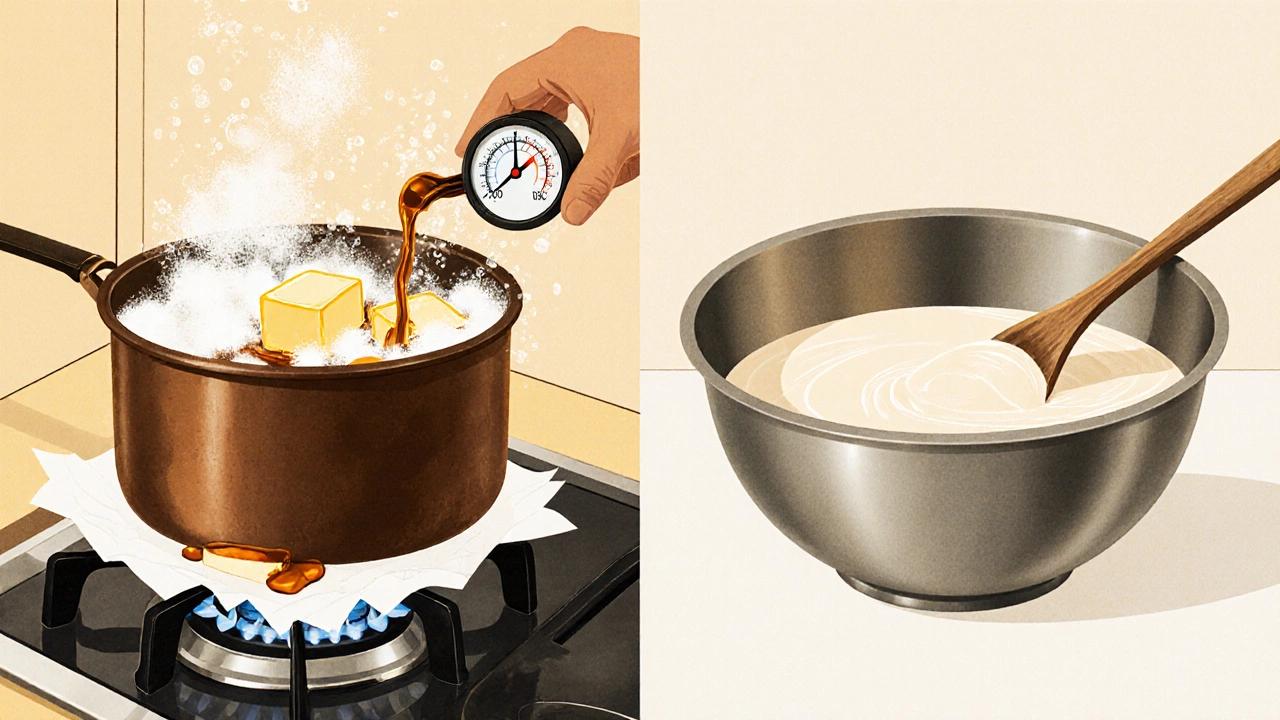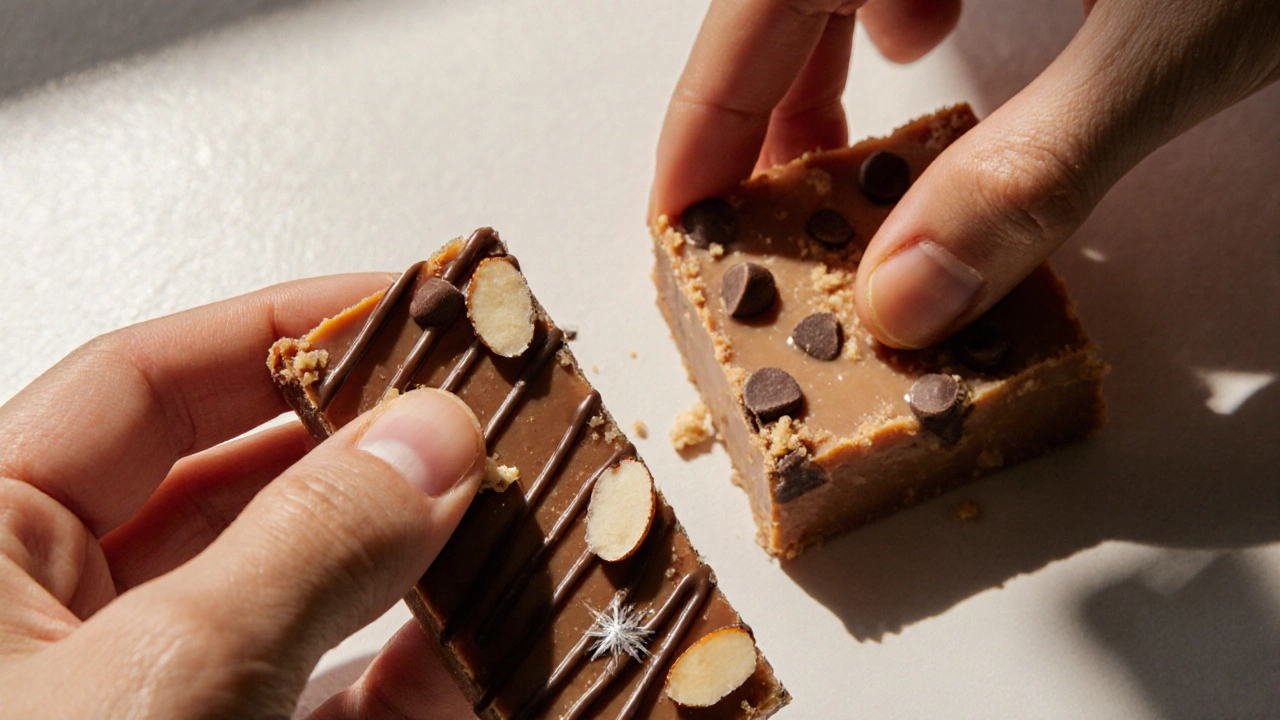Toffee vs Fudge Identifier
Result
Quick Comparison
| Aspect | Toffee | Fudge |
|---|---|---|
| Primary cooking stage | Hard-ball (149–154°C) | Soft-ball (115–120°C) |
| Main dairy component | Butter (high ratio) | Milk or cream (plus butter) |
| Typical texture | Firm, snap-able, glossy | Creamy, dense, melt-in-mouth |
| Common mix-ins | Nuts, chocolate drizzle | Chocolate chips, nuts, flavor extracts |
If you’ve ever stared at a candy shop shelf wondering whether that glossy, buttery square is toffee or a creamy fudge, you’re not alone. Both belong to the family of cooked sugar sweets, yet their textures, flavors, and cooking methods set them worlds apart. Below we break down the essentials so you can spot the difference next time you shop or decide which treat to make at home.
What is Toffee?
Toffee is a hard, buttery confection made by cooking sugar with butter (and sometimes a splash of water or cream) to the hard‑ball stage, about 149‑154°C (300‑310°F). It originated in the United Kingdom in the early 19thcentury and became popular as a sweet that could be sliced and wrapped, often studded with almonds or chocolate.
Key to a good toffee is the precise temperature and the way the sugar syrup crystallizes as it cools. A proper toffee snaps when broken, yet it can also have a slight chew if cooked a few degrees lower.
What is Fudge?
Fudge is a soft, dense confection created by gently heating a mixture of sugar, butter, and dairy (usually milk or cream) to the soft‑ball stage, roughly 115‑120°C (240‑248°F), then cooling and beating it until tiny sugar crystals form.
The beating process gives fudge its characteristic creamy, melt‑in‑your‑mouth texture. Classic versions include chocolate, vanilla, and peanut butter, but countless variations exist, from salted caramel to espresso.
Core Ingredient Differences
- Sugar provides the sweet base for both candies; the amount and type (granulated, brown) influence flavor and color.
- Butter adds richness and a buttery aroma. Toffee typically uses a higher butter‑to‑sugar ratio than fudge.
- Cream or whole milk is essential for fudge, creating a smooth mouthfeel and lowering the cooking temperature.
- Water is often added to toffee at the start to help dissolve the sugar evenly before the mixture reaches the hard‑ball stage.
Because fudge incorporates more dairy, it stays softer after cooling. Toffee’s higher cooking temperature drives off most moisture, leaving a firm, glass‑like structure.

Texture and Flavor Profiles
When you bite a piece of toffee, you first hear a crisp snap, followed by a buttery, sometimes caramel‑rich melt that can linger for several seconds. The flavor may be pure butter‑sugar, or enhanced with vanilla, nuts, or a chocolate coating.
Fudge, on the other hand, yields a gentle give under the teeth. Its creamy interior releases the flavor instantly - think deep chocolate, smooth vanilla, or the salty‑sweet punch of caramel. The texture is dense yet crumbly, making it easy to cut into squares.
Making Toffee vs. Making Fudge
- Measure precisely. A candy thermometer is a must for both, but the target range differs.
- Heat the mixture. For toffee, combine sugar, butter, and a splash of water, then bring to a boil. Stir until the sugar dissolves, then increase heat until the thermometer reads 149‑154°C.
- Cool and set. Pour the hot toffee onto a greased surface, spread thin, and let it cool. Optionally press almonds or drizzle chocolate while still warm.
- Fudge route. Melt sugar, butter, and cream together, reaching 115‑120°C. Remove from heat, let it sit briefly, then beat vigorously with a wooden spoon or electric mixer until it thickens and loses its gloss.
- Final set. Transfer the fudge into a greased pan, smooth the top, and let it rest at room temperature for at least two hours before cutting.
The biggest pitfalls? Over‑cooking fudge (it becomes hard like toffee) or under‑cooking toffee (it stays sticky and won’t snap).
How to Tell Them Apart at a Glance
- Appearance. Toffee is generally glossy and may have a uniform amber hue. Fudge is matte, often speckled with mix‑ins like nuts or chocolate chips.
- Snap test. Gently tap a piece. A clean snap signals toffee; a soft give signals fudge.
- Temperature feel. Warm a small piece between fingertips. Toffee feels firm and dry; fudge feels slightly oily and pliable.
- Ingredient clues. Look for a chocolate coating - that’s common on toffee. Fudge often lists “cream” or “milk” near the top of the ingredient list.

Common Myths Debunked
Caramel is often confused with both toffee and fudge. While caramel is a cooked sugar product, it’s usually made with just sugar and cream at the soft‑ball stage, yielding a chewy, gooey texture. Toffee and fudge, by contrast, rely on butter and a precise temperature range to achieve their distinct snaps or creams.
Another myth claims that all “brown” candies are the same. In reality, the color comes from the Maillard reaction (protein‑sugar interaction) in toffee, whereas fudge’s brown hue comes from the caramelization of dairy sugars.
Quick Reference Table
| Aspect | Toffee | Fudge |
|---|---|---|
| Primary cooking stage | Hard‑ball (149‑154°C) | Soft‑ball (115‑120°C) |
| Main dairy component | Butter (high ratio) | Milk or cream (plus butter) |
| Typical texture | Firm, snap‑able, glossy | Creamy, dense, melt‑in‑mouth |
| Common mix‑ins | Nuts, chocolate drizzle | Chocolate chips, nuts, flavor extracts |
| Cooling method | Spread thin, cool on slab | Set in pan, rest at room temp |
Tips for Perfect Results
- Use a heavy‑bottomed saucepan; it distributes heat evenly and reduces hot‑spots.
- Never stir a toffee mixture once it reaches a boil; this can cause crystal formation and a grainy texture.
- For fudge, make sure the mixture cools to about 90°F before beating; this encourages the right crystal size.
- Store toffee in an airtight container with parchment paper between layers to keep it from absorbing moisture.
- Fudge benefits from a short chill in the refrigerator after setting; it firms up without becoming hard.
Frequently Asked Questions
Can I use margarine instead of butter in toffee?
Margarine lacks the milk solids that give butter its rich flavor, so the toffee will taste flatter. It also changes the water content, making it harder to achieve that clean snap.
Why does my fudge turn out grainy?
Graininess occurs when large sugar crystals form. This can happen if you beat the fudge too early, stir while it’s still hot, or don’t let it cool to the right temperature before beating.
Is toffee considered a type of caramel?
Not exactly. Caramel is usually made with sugar and cream at a lower temperature, resulting in a softer chew. Toffee’s higher heat and butter focus make it harder and more buttery.
Can I add flavor extracts to toffee?
Yes, but add them after you remove the pan from heat. Adding extracts too early can cause them to evaporate during cooking.
How long does homemade fudge keep?
Stored in an airtight container at room temperature, fudge stays fresh for about 2weeks. Refrigerate for longer storage, but it may become firmer.
Now you’ve got the lowdown on what really sets toffee apart from fudge. Whether you’re eye‑balling treats at the shop or planning a kitchen experiment, those temperature cues, ingredient ratios, and texture tests will guide you every step of the way.